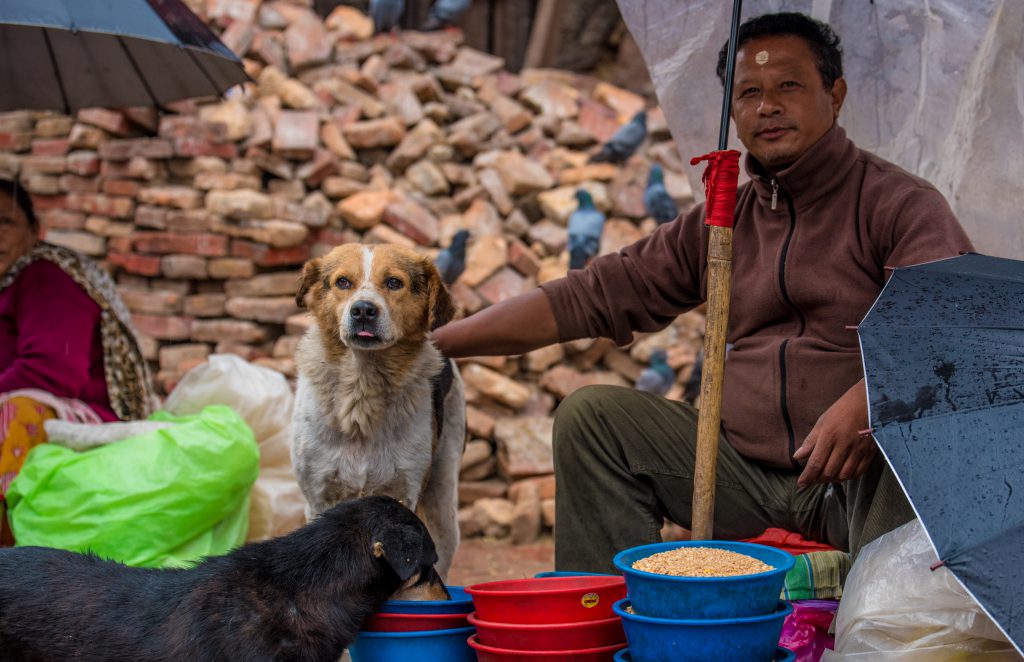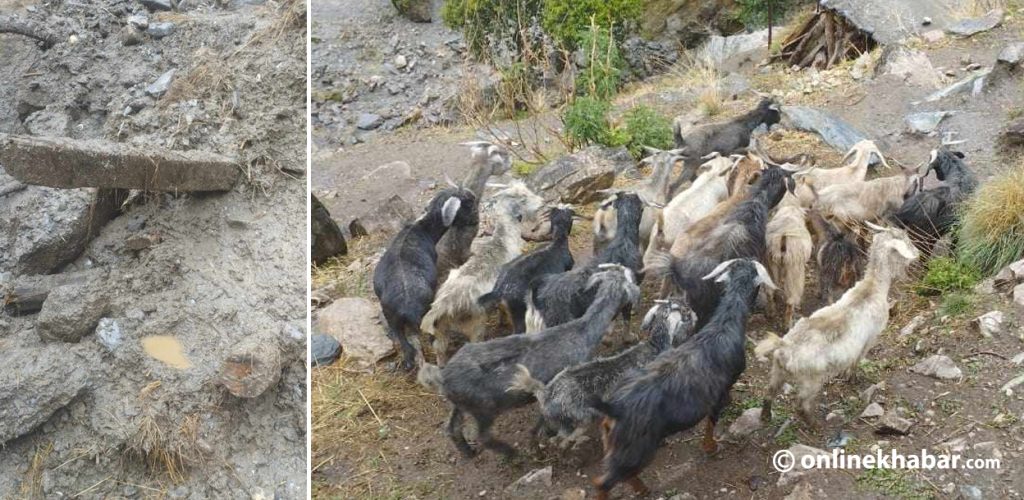Beena Maharjan starts her day by feeding the dogs in her neighbourhood. This has been her routine for the last five years. She does not mind feeding them twice a day, but when it comes to spaying and neutering the dogs, she hesitates.
That is when she came in touch with trainers and volunteers of Manumitra, a dog welfare community programme, that made her job rather easy. Maharjan, who lives in ward 12 of Kathmandu, now is a focal person and attends all calls related to the dogs in her ward.
Like Maharjan, Neru Thapa Shrestha of ward 29 was also active in her ward when it came to dogs in her neighbourhood. “But doing it alone was rather hectic. From keeping track of the number of dogs to vaccinating them, also collecting money and advocating for the welfare of dogs, all is too much work for an individual. When Manumitra came to our ward, the job got rather easy.”
Though what worried Shrestha is that Manumitra will discontinue. “There was a delay in budget allocation for the programme from the Kathmandu metropolitan city (KMC) and we immediately saw its repercussions in the locality,” she says, “We realised that the local units are not yet equipped to handle the dogs in the community. The issue of community dogs will not be solved in one day. Only when such campaigns are running that facilitate the needs of the locals will we feel safe.”
Yet, stakeholders believe the project will continue with the support of the local government as well as the community as it has been successful and the community still needs it.
A hopeful campaign

The Manumitra programme was inaugurated at Singha Durbar, which is now already a dog management zone, in 2016. The campaign is a community dog welfare solution and has been designed by the Jane Goodall Institute Nepal with the Kathmandu city government.
“There was a need for sustainable development. The Manumitra campaign could fill that gap given its model of sustainability with a focus on check and balance,” says Sangita Sapkota, the programme coordinator.
For the past five years, Manumitra has been running simultaneous programmes for dog welfare in all 32 wards of the city. Before the programme, Kathmandu lacked an integrated successful programme but more dispersed projects.
Explaining the campaign, she further shares, “We first divided Kathmandu into eight zones according to the person-to-dog ratio and started with ward 20 which fell into zone two with the highest ratio.”
“In the initial stages of the Manumitra programme, we spent some five months working in ward 20, framing a model that works with a major focus on increasing community involvement and awareness regarding the community dogs. We wanted to build a model that can be proved effective and can later be handed over to the local units,” says Sapkota.
The impact of the programme can also be seen in the declining dog population and the fewer lactating dogs along with healthier dogs. The number of dogs with reproductive organ-related disease and transmissible venereal tumours (TVTs) is also decreasing. Among the dogs still roaming the streets, one can see lower aggression and become more social.
Individual response

Bikash Shrestha, a veterinarian working for the Manumitra programme, says the dogs are treated and collared with neon belts so that they can avoid falling victims to accidents. Likewise, those spayed/neutered are marked V or U. “We are also working so that the dogs are recorded, for their identification (pedigree sheet) with microchipping to track the dogs.”
Once associated with the programme, people cannot leave dogs elsewhere or kill them either, Sapkota adds. The impact of the Manumitra programme can be seen in the number of animal cruelty cases and the response from the community, given that there was an active backlash against the few animal cruelty cases last year. Because of the awareness, when any harm is caused to the community dogs, it is the community that makes the abusers pledge that it will not happen again and also be penalised, as per the law.
Meanwhile, the programme is also working to build dog management zones as it did in Singha Durbar, where it also set up a common feeding zone as well as a proper shelter for them, with a proper fencing area for dogs in their designated area (inside or outside the fence). It also aimed to set up an environment where the dogs are well-treated and free of misbehaving and animal cruelty.
Unique working style

In every ward, the Manumitra programme connects locals and makes them responsible for the dogs in their community. The programme calls them AMA (animal management assistants), all of whom work under their respective ward offices.
The original plan was to hand over the Manumitra programme to the government after the campaign ends. “However, it is still being dragged behind for some reason.”
It means Manumitra wants to provide technical support only to the local units as they might not be equipped with technical aspects and human resources. For the government to get experienced human resources and physical infrastructure will still take time.
“People are still calling the Manumitra office rather than reaching out to the local units and committees. There is a lack of a mechanism at both local and national levels. Though people are seen as interested to be involved, there is no one to take responsibility for. If we pull back, the situation will revert,” Sapkota says.
Lack of understanding

In the past five years, the Manumitra campaign has been the only external programme that has been deemed successful in all Kathmandu wards, the project claims. “The programme has been renewed by all KMC wards, with a separate budget allocated for its work. We take it as a win.”
However, the team complains that the campaign has been privy to some misunderstandings. According to Bikash Shrestha, the veterinarian, “Manumitra is not just about clinical treatment though it is an important part. The campaign is attempting to change the vocabulary of the people although it is more difficult to change.”
Basanta Gautam, the community coordinator of the Manumitra programme, adds, “People commonly refer to them as stray or street dogs, but we prefer to say they are community dogs as they live and survive in their community. Though not a pet, it has always been our nature/norm to take care of dogs, name them and feed them. So, it is time we rephrase how we see them.”
Also, the programme corrected people’s perception that dogs of better breeds also are likely to get abandoned and they suffer similar consequences.
Another gap in understanding, the campaigners feel, is in making the people understand what the campaign stands for. But, in that, focus group discussions helped them a lot. “We held multiple FDGs with community stakeholders, shopkeepers, meat vendors, sweepers and community individuals as well as school children to educate them and their families, through them.”
Retrospectively, the Manumitra campaign says the first year showed more progress than the consecutive years. “Starting the second year, we started having more challenges to make the government more active and responsible. Even today, we feel that the cooperation with the people is still lacking whereas meeting the deadlines and timely use of resources is a challenge too,” says Sapkota.
The campaign also suffered a bit because those in the authorities, especially at the department or ministerial levels, only lasted up to a year with the changing government.
What’s the future?

In its last survey, the Manumitra programme found there are 22,000 dogs in the streets of Kathmandu valley. In the past five years, the campaign has already reached 17,000 dogs and is in the process to reach more. However, the team is sceptical about the project’s future as the project is nearing its end.
Though deemed a successful project, the project has barely received ample media coverage or discussion around it. Also, the need for this initiative or its replication has not been discussed. “Local bodies have the network, but their priorities were never in building a dog community, rather it was just on the immediate impact,” she adds.
With the election of the new leadership, she is hopeful that the project will get a priority and will be continued and replicated in all 32 wards of the city and beyond as they expect Kathmandu wards to act as buffer areas to create bigger impacts.
“The locals and the local units are more than eager to continue the programme, but the issue of budgeting and priorities including the lack of representational initiatives will determine the scale and impact,” says Basanta Gautam.
“The programme will always be relevant because there will be dogs that are abandoned on the streets, and many new dogs will be in need of treatment,” informs Awadesh Jha, a senior veterinarian officer of the Livestock Service Division under the city government.
Regarding the continuation of the project, Jha says that it will continue for sure. However, the model in which the programme will be operated is yet to be known. “We have to be independent and are brainstorming around how we can run the programme with our own capacity and resources. Yet, we do not have field workers like dog catchers so that will create an issue for the programme if we are to do it on our own. So we cannot do it on our own right away.”
Jha adds the municipal government is very positive about the Manumitra programme and, with the new local government, further details will be known by the end of June. He stresses the need for collaboration with other similar organisations to expand its coverage in not just the Kathmandu city but the entire Kathmandu valley.
Meanwhile, he says that dog owners need to be more responsible as well and help the city government in its ongoing data collection for better dog management.





















